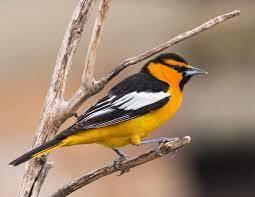
BIRD OF THE MONTH: BULLOCK'S ORIOLE
Rarely seen at feeders, the Bullock's Oriole is a beautiful songbird that resides in open woodlands in our state. Adult males are flame-orange with a black line through the eye and a black throat. Females and immature orioles are washed in gray and yellowish-orange. Immature males show a black throat patch. They are medium-sized with slim but sturdy bodies and a medium-long tail. The bill is long, thick-based and sharply pointed.
Bullock's Orioles feed in the slender branches of trees and shrubs, catching caterpillars and also feeding on nectar or fruit. They glean insects from leaves, branches and trunks nimbly hopping and dangling as they forage and will even pluck insects from spiderwebs or from the air. They will take fresh berries from bushes and fruit from trees. These birds have been known to come to sugar-water feeders, fresh cut orange halves set out in water to discourage ants, and a 50/50 blend of water and grape jelly but are usually not seen in yards and residential areas.
This bird can be found in open woodland along streams, particularly in cottonwoods. They can also be seen in orchards and parks. Bullock's Orioles prefer areas where the trees are large and spaced well apart or in isolated clumps.
The female usually weaves the nest but the male may assist with one partner working on the inside and the other outside bringing nesting material. It can take up to 15 days to complete a nest. The nest is gourd-shaped and neatly woven from fibers such as hair, twine, grasses, or wool. It is lined with soft materials such as feathers, the "cotton" from cottonwoods or willows.
The male performs a bowing courtship display, hopping from branch to branch and bowing to the female every second or so, all the while singing loudly and exposing his colorful plumage. During nest-building and border disputes, the female may display with quivering wings, holding her body in a roughly horizontal position. Both members of a pair guard the nest and may mob squirrels, crows, jays and other predators. Females tend to sing near the nest site, while males sing elsewhere. The male tends to sing more sweetly while the female sings more prolifically.
Bullock's Oriole pairs may nest outside the territory where the male advertises.
The Bullock's Oriole was described and named by William Swainson in 1827 using material collected by English father-and-son naturalists William and William Bullock.
The oldest recorded Bullock's Oriole was a male and he was at least 8 years, 11 months old when he was recaptured and rereleased during banding operations in Colorado in May, 2007.
Bullock's Orioles and their nests have been seen at North Wind's Weir in Tukwila and in cottonwood trees growing along the Green River.

